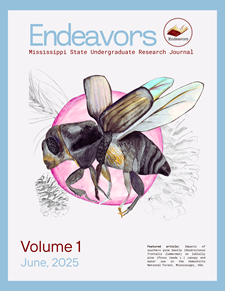Sasha Goodnow, Yun Yang, Hui Liu, Ashley Schulz
Abiotic and biotic forest disturbances can have many impacts to forest ecosystem
services, including to forest water use. Studies on impacts to forest
evapotranspiration have been conducted on the mountain pine beetle (Dendroctonus
ponderosae) in western North America, but not on the southern pine beetle
(Dendroctonus frontalis), which is a native pest of loblolly pine (Pinus taeda)
and shortleaf pine (Pinus echinata), in the southeastern United States. Stressed
pine trees produce pheromones that attract southern pine beetles and, with
enough stressed trees, beetle populations can quickly grow to epidemic levels
and attack healthy trees, which results in widespread tree mortality. This study
aimed to examine the impact of southern pine beetle spots on canopy density and
evapotranspiration in loblolly pine stands in the Homochitto National Forest
from 2012-2021. Locations of documented beetle spots from the USDA Forest
Service were used to extract normalized difference vegetation index (NDVI)
values using Landsat satellite observations on Google Earth Engine, and
evapotranspiration data at stand level from the OpenET platform for two years
pre- and post-southern pine beetle detection for comparative analysis. Results
demonstrate that southern pine beetle outbreaks reduce NDVI and
evapotranspiration, but also highlight that other factors (e.g., understory
vegetation) can result in stand-by-stand variation in hydrologic cycle impacts.
Further, this study demonstrates that satellite observations can provide
critical environmental data on impacts of forest pests. By understanding the
relationships between biotic disturbance agents and forest water use capability
in forest ecosystems, we can improve our understanding of the impacts of forest
disturbance agents on ecosystem services and possibly help direct management of
forest stands impacted by these disturbances.